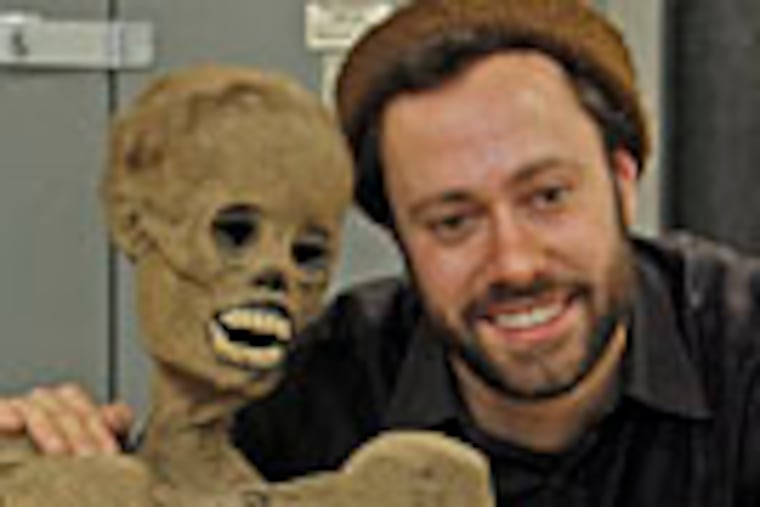He's the dummy-mummy maker
Misplaced your mummy? Left it (he? she?) behind on your last vacation? That's the predicament that befell folks at the University of Pennsylvania Museum of Archaeology and Anthropology when they found that Chinese officials didn't want them to display more than 100 artifacts from China in the museum's much-ballyhooed "Secrets of the Silk Road" exhibition, as well as its centerpiece: two ancient, perfectly preserved mummies.

Misplaced your mummy?
Left it (he? she?) behind on your last vacation?
That's the predicament that befell folks at the University of Pennsylvania Museum of Archaeology and Anthropology when they found that Chinese officials didn't want them to display more than 100 artifacts from China in the museum's much-ballyhooed "Secrets of the Silk Road" exhibition, as well as its centerpiece: two ancient, perfectly preserved mummies.
As luck would have it, the museum had on staff an experienced mummy maker (mummier? mummyfabricator? Um, mummer?) - perhaps the only one for hundreds, if not thousands of miles around.
Meet Benjamin Neiditz, artist, sculptor, carpenter, and - mummy guy.
"When the China situation arose, Ben immediately came to mind," says director of exhibits Kate Quinn.
She says Neiditz had made a faux mummy in 2008 as part of an art installation and later let the museum's education department use it so "kids could have a chance to see and touch a mummy up close. You know, to add that cool factor."
Cool indeed: That mummy, a life-size number with a comic tuft of hair atop his pate, even sports white-and-blue sneakers.
"We knew we were using photographs [in place of the missing artifacts] for the exhibit," Queen said. "But for [the mummies], we wanted to have something a little more real. They are icons . . . arguably the most interesting part of the exhibition."
Neiditz jumped at the chance.
"He was really excited about it," says Quinn.
(The artifacts, and the mummies, have since been cleared for display and will go on view at the museum beginning Friday and continuing through March 15. The show will reopen March 17, with fake mummies again in place. The rest of the Chinese objects will remain on display until March 28; the exhibition, in its opening form, will continue through June 5.)
Neiditz, 28, who has been an exhibits fabricator at the museum since October 2009, is slim, understated, laid-back.
"I had a blast making these mummies," he says of the two papier-mâché dummies he created using photos of the originals. The first, a 3,800-year-old woman from western China, has been dubbed the Beauty of Xiaohe. The other, Baby Bluebonnet, is a 2,800-year-old infant.
A Boston native who has lived in Philly for six years, Neiditz sports a dark knit cap as he guides a visitor through the exhibit.
He says his two passions are art and political activism.
After graduating from Vassar College in Poughkeepsie, N.Y., in 2004 with a political science degree, he went on a trip to Israel, where he worked with pro-Palestinian activists.
He was stunned to be asked to make the "Silk Road" mummies. "It's a hilarious twist of fate," he says with a laugh.
"I think it's really absurd that I should have been working at my own art and ended up making a fake corpse and then being called upon in my job to do that. I am still speechless."
Neiditz displayed his initial mummy - the unnamed sneaker dude - in late 2008 at a group art exhibition at the Padlock Gallery in South Philly. He says he created it as a lark, to add humor to the show.
He never named the piece, though he reluctantly admits "it's a self-portrait . . . at least I like to think of him that way." After all, its head is crowned with Neiditz's own hair
"It freaked people out a bit," he says. "People thought it was more realistic than I thought it was."
His latest art project is a life-size, two-story dwelling he created with found material on an abandoned lot in West Philly.
But the success of his mummies has made him rethink his future.
"The response I have received definitely has reignited my interest in making fake corpses," he says, laughing. "People even tell me I could make money selling them to museums."
Just museums? Can't private mummy lovers get them, too?
"Sure, I would be happy to make corpses for anyone."